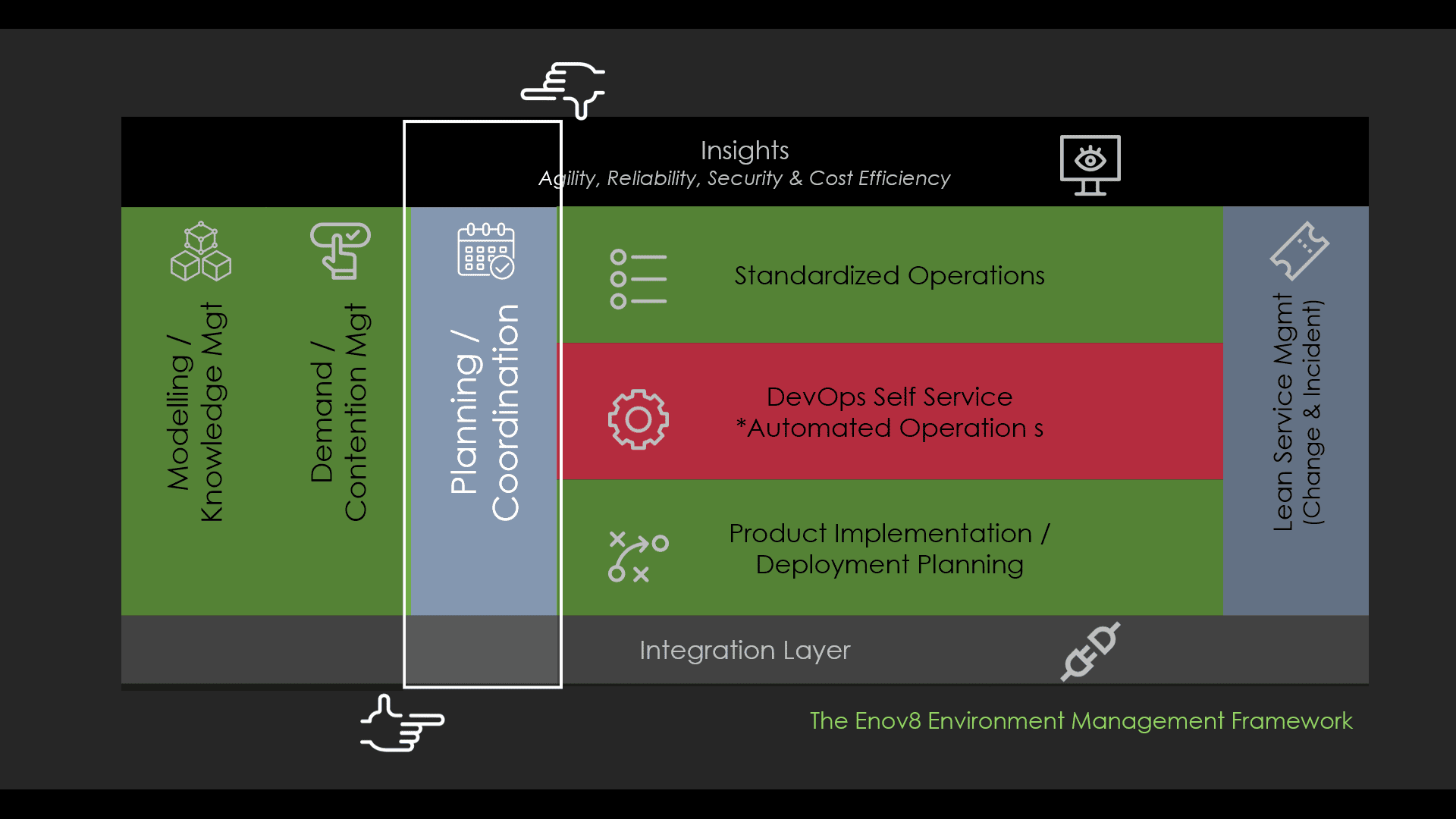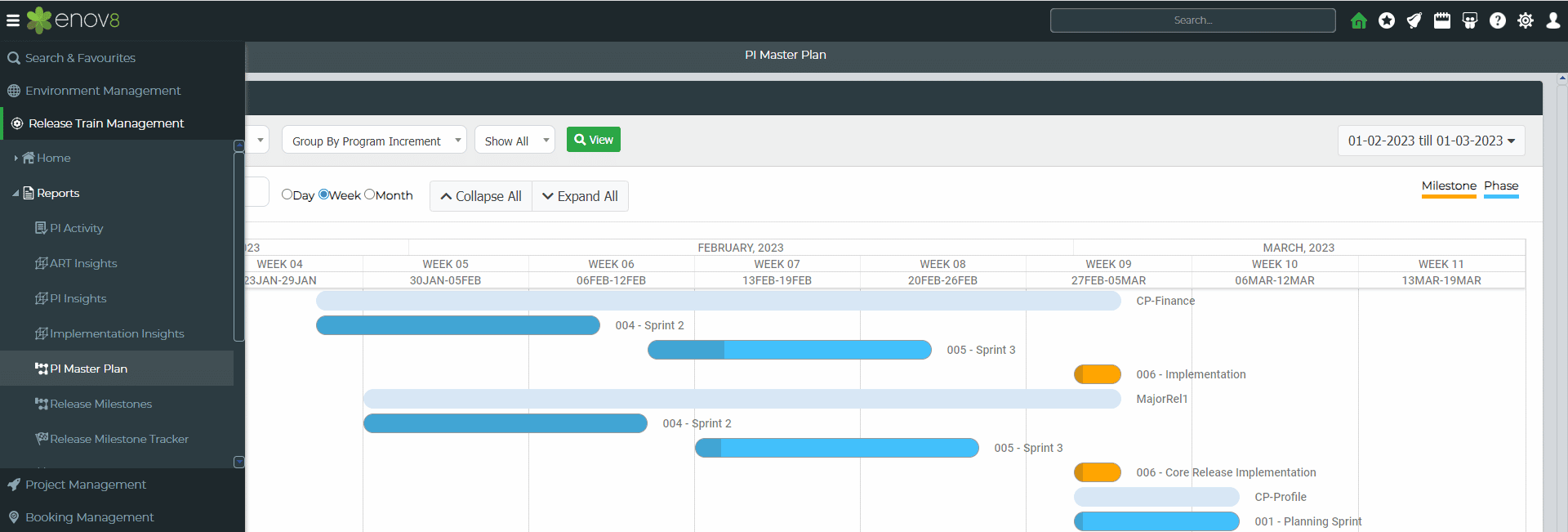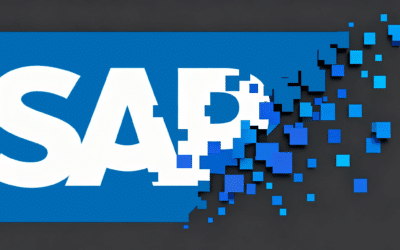
Test Environment & Release – Planning & Coordination
FEB, 2023
by Jane Temov.
Jane Temov is an IT Environments Evangelist at Enov8, specializing in IT and Test Environment Management, Test Data Management, Data Security, Disaster Recovery, Release Management, Service Resilience, Configuration Management, DevOps, and Infrastructure/Cloud Migration. Jane is passionate about helping organizations optimize their IT environments for maximum efficiency.
Test Environment and Release Management are two critical components of Software Development and Product Lifecycle Management. The success of any application launch is dependent on effective planning and coordination.
Enov8 IT & Test Environment Manager
*Innovate with Enov8
Streamlining delivery through effective transparency & control of your IT & Test Environments.
This paper will discuss the importance of planning and coordination in (A) Test Environment and (B) Release Management, the role of calendars and schedules in the process, and best practices for success.
(A) IT & Test Environment Management Planning & Coordination
Understanding Test Environment Management
Definition of Test Environment Management
Test Environment Management is the process of designing, deploying, and maintaining a test environment specifically for the purpose of testing software applications. This includes setting up the hardware and software, configuring the environment, and managing the access and security of the environment.
Objectives of Test Environment Management
Test Environment Management aims to ensure that applications are tested in a realistic environment that closely mirrors the production environment. This allows the application to be tested in conditions that are as close to production as possible, which increases the accuracy of the testing results.
Planning and Coordination in Test Environment Management
Importance of planning and coordination in the process
Planning and coordination are essential for successful Test Environment Management. Without proper planning and coordination, the test environment may not accurately reflect the production environment, resulting in inaccurate test results. Planning and coordination also ensure that resources are available when needed, that deadlines are met, and that the process runs smoothly.
Key elements of planning and coordination
Planning and coordination in Test Environment Management involves the following elements:
- Establishing goals and objectives
- Defining the scope of the project
- Identifying the test environment requirements
- Establishing a timeline for the project
- Scheduling resources
- Managing access and security
- Monitoring and evaluating the process.
The use of Calendars and Schedules in Test Environment Management
Benefits of using calendars and schedules
Using calendars and schedules in Test Environment Management helps ensure that tasks are completed on time and that resources are available when needed. Calendars and schedules also provide an overview of the project timeline and allow stakeholders to easily track progress.
Types of calendars and schedules used in the process
The following types of calendars and schedules are commonly used in Test Environment Management:
- Deployment schedules
- Change Schedules
- Environment Outages / Freezes
- Patching Schedules
- Security Schedules
How to create and maintain calendars and schedules
Creating and maintaining calendars and schedules in Test Environment Management begins with identifying the tasks that need to be completed and their respective timelines. This information is usually derived from Service Requests (e.g. RFCs) and Release Implementation, or Deployment, Plans.
Using Environment Management Tools like Enov8 Environment Manager the tasks should then be assigned to appropriate resources and timelines should be established. The calendars and schedules should then be regularly reviewed and updated to reflect any changes in the process.
Tip: In ITIL this IT Environment Schedule is often referred to as a “Forward Schedule of Change” (FSC).
A Forward Schedule of Change (FSC) is a document or system used in IT Service Management (ITSM) that details the upcoming changes that will be made to an IT environment. It is essentially a schedule or calendar of planned changes, allowing the IT team to manage and coordinate the implementation of changes in an organized manner.
The FSC typically includes details such as the date and time of the planned change, a description of the change, the reason for the change, the expected impact of the change, and any risks or issues associated with the change. It may also include information on the individuals or teams responsible for implementing the change, as well as any testing or approval processes that need to be completed prior to implementation.
Having a well-maintained FSC is essential for ensuring that changes are implemented in a controlled and predictable manner, with minimal disruption to the IT environment and business operations. It also helps to ensure that all stakeholders are aware of the upcoming changes and can plan accordingly.
Test Environment Management Best Practices for Planning & Coordination
Communication and collaboration
Effective communication and collaboration between stakeholders is essential for successful Test Environment Management. This includes communicating the project goals and objectives, as well as any changes or updates to the project timeline. It is also important to ensure that all stakeholders are aware of their roles and responsibilities in the project.
Risk management
Risk management is an important part of Test Environment Management. It involves identifying potential risks and taking steps to mitigate those risks. This includes monitoring the process and evaluating the results to identify any areas of concern that may need to be addressed.
*examples of risk include: unexpected hardware or software issues, security vulnerabilities, insufficient capacity, etc.
Continuous improvement
Continuous improvement is an important part of Test Environment Management. This involves regularly evaluating the process, identifying areas for improvement, and making adjustments accordingly. It is also important to document any changes or updates to the process so that they can be referenced in the future.
Enov8 for Planning & Coordination
Why Enov8 IT & Test Environment Manager
Enov8 IT & Test Environment Manager is an on-premise or SaaS based platform that helps organizations manage their test environments more efficiently. It provides an automated and centralized approach to managing test environments, allowing users to create and manage test environments in minutes. It also simplifies the process of planning and coordinating test environment changes, enabling teams to quickly respond to business needs. It also provides visibility into the test environment, allowing teams to monitor and track progress.
Enov8 Environment Manager, Calendar View: Screenshot
(B) Release Management Planning & Coordination
Understanding Release Management
Definition of Release Management
Release Management is the process of planning, scheduling, and controlling the deployment of software applications to production environments. It involves the coordination of activities between development and operations teams, as well as other stakeholders, to ensure that applications are released on time and in compliance with organizational standards.
Objectives of Release Management
The primary objectives of Release Management are to ensure that applications are released on time, with minimal disruption to production environments, and in compliance with organizational standards. It also aims to ensure that applications are tested in a realistic environment that closely mirrors the production environment.
Planning and Coordination in Release Management
Importance of planning and coordination in the process
Planning and coordination are essential for successful Release Management. Without proper planning and coordination, the release process may not be completed on time, the application may not be tested in a realistic environment, and the application may not be released in compliance with organizational standards. Planning and coordination also ensure that resources are available when needed, that deadlines are met, and that the process runs smoothly.
Key elements of planning and coordination
Planning and coordination in Release Management involves the following elements:
- Establishing goals and objectives
- Defining the scope of the project
- Identifying the release requirements
- Establishing a timeline for the project
- Scheduling resources
- Managing access and security
- Monitoring and evaluating the process.
The use of Calendars and Schedules in Release Management
Benefits of using calendars and schedules
Using calendars and schedules in Release Management helps ensure that tasks are completed on time and that resources are available when needed. Calendars and schedules also provide an overview of the project timeline and allow stakeholders to easily track progress.
Types of calendars and schedules used in the process
In the context of Enterprise Release Management (ERM), various types of calendars and schedules are used to plan and manage the release process effectively. Some of the commonly used calendars and schedules are:
- Release Calendar: A high-level overview of all the planned releases, including the release dates, milestones, and the resources involved.
- Sprint Schedule: A time-boxed iteration of work, typically lasting one to four weeks, that helps teams plan and prioritize tasks and delivery of software.
- Project Schedule: A detailed timeline of all the tasks and activities involved in a project, including dependencies, deadlines, and resources required.
- Implementation Day Schedule: A plan for implementing and deploying software releases to production environments, including the dates, locations, and resources involved.
- Communication Plan: A plan for communicating key information about releases to stakeholders, including the schedule, risks, and impact.
How to create and maintain calendars and schedules
Creating and maintaining calendars and schedules in Release Management begins with identifying the tasks that need to be completed and their respective timelines. This information is usually derived from Release Plans, Requirements Documents, and Design Specifications.
Using Release Management Tools like Enov8 Release Manager, the tasks should then be assigned to appropriate resources and timelines should be established. The calendars and schedules should then be regularly reviewed and updated to reflect any changes in the process.
Release Management Best Practices for Planning & Coordination
Communication and collaboration
Effective communication and collaboration between stakeholders is essential for successful Release Management. This includes communicating the project goals and objectives, as well as any changes or updates to the project timeline. It is also important to ensure that all stakeholders are aware of their roles and responsibilities in the project.
Risk management
Risk management is a critical aspect of Enterprise Release Management (ERM) and involves identifying, assessing, and mitigating potential risks that may impact the success of a software release. Examples of risk management practices in the context of ERM:
Threat Assessment: A systematic evaluation of the potential risks and vulnerabilities associated with a software release, including technical, operational, and business risks.
- Impact Analysis: A determination of the potential consequences of a risk occurring, including the impact on the project schedule, budget, and quality.
- Contingency Planning: The development of contingency plans to mitigate the impact of risks, including backup plans, fallback options, and alternate approaches.
- Risk Mitigation: Implementing specific measures to reduce the likelihood of a risk occurring, such as code reviews, testing, and security measures.
- Risk Monitoring: Regularly tracking and monitoring the status of identified risks, including the implementation of mitigation measures and the ongoing evaluation of risk exposure.
- Issue Tracking: Recording and managing potential issues and risks, including the identification of root causes and the implementation of corrective actions.
- Stakeholder Communication: Keeping stakeholders informed about potential risks and their mitigation plans, as well as ensuring that all stakeholders are aligned with the risk management approach.
These risk management practices help organizations ensure that software releases are executed in a controlled and predictable manner, minimize the impact of risks, and ensure that the release process is aligned with the organization’s goals and objectives.
Continuous improvement
Continuous improvement plays a crucial role in Release Management. It involves regularly assessing the process, pinpointing areas that need enhancement, and making necessary changes. Documentation of any modifications or advancements to the procedure is also crucial, as it allows for future reference.
Enov8 for Release Planning & Coordination
Why Enov8 Release Manager
Enov8 Release Manager is a platform that offers on-premise or cloud-based solutions to organizations looking to streamline their software release management processes. With its automated and centralized approach, this platform allows users to easily plan and organize software releases in a matter of minutes. The platform simplifies the process of planning and coordinating release changes, enabling teams to quickly adapt to changing business requirements. Additionally, Enov8 Release Manager provides transparency into the release process, allowing teams to keep track of progress and make informed decisions.
Enov8 Release Manager, Program Planning View: Screenshot
Final Thoughts on Best Practices for Success
For successful Test Environment and Release Management, it’s crucial to maintain effective communication and cooperation among stakeholders, implement effective risk management, and prioritize continuous improvement. Utilizing calendars and schedules can guarantee timely completion of tasks and availability of resources.
Implementing tools such as Enov8 IT & Test Environment Manager and Enov8 Release Manager can help streamline the process, ensuring that applications are tested and released quickly and efficiently.
Other Reading
Enov8 Blog: Managing Test Environment Demand & Avoiding Contention
Enov8 Blog: Test Environment Management Modelling
Relevant Articles
Your Essential Test Environment Management Checklist
“Test Environment Management Checklist.” Yep, that sounds like a mouthful, but don’t let that discourage you. The idea here is quite simple—adopting a checklist to evaluate the soundness of your test environment management approach. Even though the idea sounds simple...
A Detailed Guide to SAP Data Masking
SAP systems handle some of the most sensitive data in the enterprise: financial transactions, HR information, supplier records, customer profiles, operational details, and more. For that reason, copying production data into non-production systems without modification...
Release vs Deployment Management: What’s the Difference?
In the always-an-adventure world of IT service management, there are several key processes that are essential for delivering high-quality services to customers and end-users. Two of the most critical processes are release management and deployment management. These...
7 Tools to Help with Application Rationalization
Application rationalization is the process of identifying which applications an organization should keep, update, consolidate, or retire. Think of it as a financial adviser, but instead of your investment portfolio, it's your application portfolio. Most companies take...
Pairing DevOps with Test Environment Management
For many organizations, DevOps is the best practice for efficiency. However, this model doesn’t come easily as the organization needs to put certain things in place. For example, the firm needs to incorporate the right tools to ensure its delivery pipeline and...
8 DevOps Anti-Patterns You Should Avoid
It’s the normal case with software buzzwords that people focus so much on what something is that they forget what it is not. DevOps is no exception. To truly embrace DevOps and cherish what it is, it’s important to comprehend what it isn’t. A plethora...














